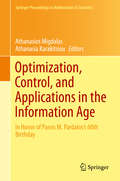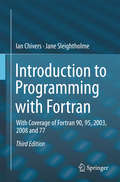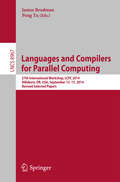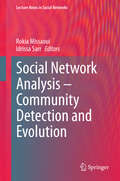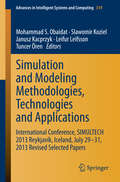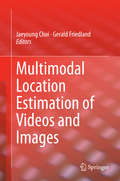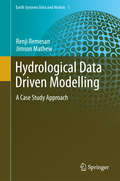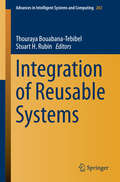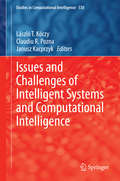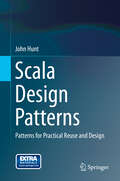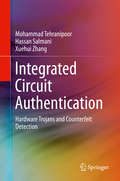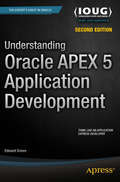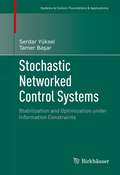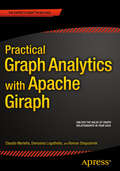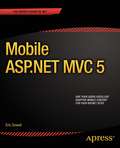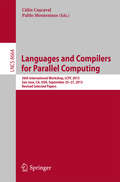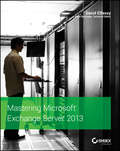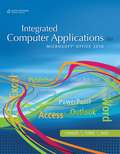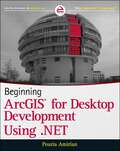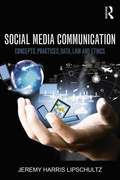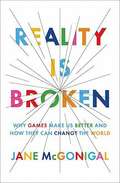- Table View
- List View
Optimization, Control, and Applications in the Information Age
by Athanasia Karakitsiou Athanasios MigdalasRecent developments in theory, algorithms, and applications in optimization and control are discussed in this proceedings, based on selected talks from the 'Optimization Control and Applications in the Information Age' conference, organized in honor of Panos Pardalos's 60th birthday. This volume contains numerous applications to optimal decision making in energy production and fuel management, data mining, logistics, supply chain management, market network analysis, risk analysis, and community network analysis. In addition, a short biography is included describing Dr. Pardalos's path from a shepherd village on the high mountains of Thessaly to academic success. Due to the wide range of topics such as global optimization, combinatorial optimization, game theory, stochastics and programming contained in this publication, scientists, researchers, and students in optimization, operations research, analytics, mathematics and computer science will be interested in this volume.
Introduction to Programming with Fortran
by Jane Sleightholme Ian ChiversThis edition has been revised to stress the use of modern Fortran throughout: Key features: lots of clear, simple and complete examples highlighting the, core language features of modern Fortran including data typing, array processing, control structures functions, subroutines, user defined types and pointers, pinpoints common problems that occur when programming, has sample output from a variety of compilers, expands on the first edition, by introducing modules as soon as the fundamental language features have been covered. Modules are the major organisational feature of Fortran and are the equivalent of classes in other languages, major new features covered in this edition include, introduction to object oriented programming in Fortran introduction to parallel programming in Fortran using MPI, OpenMP and Coarray Fortra, this edition has three target audiences the complete beginner existing Fortran programmers wishing to update their code those with programming experience in other languages Ian Chivers and Jane Sleightholme are the joint owners of comp-fortran-90 which is a lively forum for the exchange of technical details of the Fortran language. Ian is the editor of the ACM Fortran Forum and both Jane and Ian have both been involved in the Fortran standardisation process. The authors have been teaching and supporting Fortran and related areas for over 30 years and their latest book reflects the lessons that have been learnt from this.
Languages and Compilers for Parallel Computing
by James Brodman Peng TuThis book constitutes the thoroughly refereed post-conference proceedings of the 27th International Workshop on Languages and Compilers for Parallel Computing, LCPC 2014, held in Hillsboro, OR, USA, in September 2014. The 25 revised full papers were carefully reviewed and selected from 39 submissions. The papers are organized in topical sections on accelerator programming; algorithms for parallelism; compilers; debugging; vectorization.
Social Network Analysis - Community Detection and Evolution
by Rokia Missaoui Idrissa SarrThis book is devoted to recent progress in social network analysis with a high focus on community detection and evolution. The eleven chapters cover the identification of cohesive groups, core components and key players either in static or dynamic networks of different kinds and levels of heterogeneity. Other important topics in social network analysis such as influential detection and maximization, information propagation, user behavior analysis, as well as network modeling and visualization are also presented. Many studies are validated through real social networks such as Twitter. This edited work will appeal to researchers, practitioners and students interested in the latest developments of social network analysis.
Simulation and Modeling Methodologies, Technologies and Applications
by Leifur Leifsson Slawomir Koziel Mohammad S. Obaidat Janusz Kacprzyk Tuncer ÖrenThis book includes extended and revised versions of a set of selected papers from the 3rd International Conference on Simulation and Modeling Methodologies, Technologies and Applications (SIMULTECH 2013) which was co-organized by the Reykjavik University (RU) and sponsored by the Institute for Systems and Technologies of Information, Control and Communication (INSTICC). SIMULTECH 2013 was held in cooperation with the ACM SIGSIM - Special Interest Group (SIG) on SImulation and Modeling (SIM), Movimento Italiano Modellazione e Simulazione (MIMOS) and AIS Special Interest Group on Modeling and Simulation (AIS SIGMAS) and technically co-sponsored by the Society for Modeling & Simulation International (SCS), Liophant Simulation, Simulation Team and International Federation for Information Processing (IFIP). This proceedings brings together researchers, engineers, applied mathematicians and practitioners working in the advances and applications in the field of system simulation.
Multimodal Location Estimation of Videos and Images
by Gerald Friedland Jaeyoung ChoiThis book presents an overview of the field of multimodal location estimation. The authors' aim is to describe the research results in this field in a unified way. The book describes fundamental methods of acoustic, visual, textual, social graph, and metadata processing as well as multimodal integration methods used for location estimation. In addition, the book covers benchmark metrics and explores the limits of the technology based on a human baseline. The book also outlines privacy implications and discusses directions for future research in the area.
Hydrological Data Driven Modelling
by Jimson Mathew Renji RemesanThis book explores a new realm in data-based modeling with applications to hydrology. Pursuing a case study approach, it presents a rigorous evaluation of state-of-the-art input selection methods on the basis of detailed and comprehensive experimentation and comparative studies that employ emerging hybrid techniques for modeling and analysis. Advanced computing offers a range of new options for hydrologic modeling with the help of mathematical and data-based approaches like wavelets, neural networks, fuzzy logic, and support vector machines. Recently machine learning/artificial intelligence techniques have come to be used for time series modeling. However, though initial studies have shown this approach to be effective, there are still concerns about their accuracy and ability to make predictions on a selected input space.
Integration of Reusable Systems
by Thouraya Bouabana-Tebibel Stuart H. RubinSoftware reuse and integration has been described as the process of creating software systems from existing software rather than building software systems from scratch. Whereas reuse solely deals with the artifacts creation, integration focuses on how reusable artifacts interact with the already existing parts of the specified transformation. Currently, most reuse research focuses on creating and integrating adaptable components at development or at compile time. However, with the emergence of ubiquitous computing, reuse technologies that can support adaptation and reconfiguration of architectures and components at runtime are in demand. This edited book includes 15 high quality research papers written by experts in information reuse and integration to cover the most recent advances in the field. These papers are extended versions of the best papers which were presented at IEEE International Conference on Information Reuse and Integration and IEEE International Workshop on Formal Methods Integration, which was held in San Francisco in August 2013.
Issues and Challenges of Intelligent Systems and Computational Intelligence
by Janusz Kacprzyk László T. Kóczy Claudiu R. PoznaThis carefully edited book contains contributions of prominent and active researchers and scholars in the broadly perceived area of intelligent systems. The book is unique both with respect to the width of coverage of tools and techniques, and to the variety of problems that could be solved by the tools and techniques presented. The editors have been able to gather a very good collection of relevant and original papers by prominent representatives of many areas, relevant both to the theory and practice of intelligent systems, artificial intelligence, computational intelligence, soft computing, and the like. The contributions have been divided into 7 parts presenting first more fundamental and theoretical contributions, and then applications in relevant areas.
Scala Design Patterns
by John HuntScala is a new and exciting programming language that is a hybrid between object oriented languages such as Java and functional languages such as Haskell. As such it has its own programming idioms and development styles. Scala Design Patterns looks at how code reuse can be successfully achieved in Scala. A major aspect of this is the reinterpretation of the original Gang of Four design patterns in terms of Scala and its language structures (that is the use of Traits, Classes, Objects and Functions). It includes an exploration of functional design patterns and considers how these can be interpreted in Scala's uniquely hybrid style. A key aspect of the book is the many code examples that accompany each design pattern, allowing the reader to understand not just the design pattern but also to explore powerful and flexible Scala language features. Including numerous source code examples, this book will be of value to professionals and practitioners working in the field of software engineering.
Integrated Circuit Authentication
by Mohammad Tehranipoor Hassan Salmani Xuehui ZhangThis book describes techniques to verify the authenticity of integrated circuits (ICs). It focuses on hardware Trojan detection and prevention and counterfeit detection and prevention. The authors discuss a variety of detection schemes and design methodologies for improving Trojan detection techniques, as well as various attempts at developing hardware Trojans in IP cores and ICs. While describing existing Trojan detection methods, the authors also analyze their effectiveness in disclosing various types of Trojans, and demonstrate several architecture-level solutions.
Understanding Oracle APEX 5 Application Development
by Edward ScioreThis new edition of Understanding Oracle APEX 5 Application Development shows APEX developers how to build practical, non-trivial web applications. The book introduces the world of APEX properties, explaining the functionality supported by each page component as well as the techniques developers use to achieve that functionality. The book is targeted at those who are new to APEX and just beginning to develop real projects for production deployment. Reading the book and working the examples will leave you in a good position to build good-looking, highly-functional, web applications. Topics include: conditional formatting, user-customized reports, data entry forms, concurrency and lost updates, and updatable reports. Accompanying the book is a demo web application that illustrates each concept mentioned in the book. Specific attention is given in the book to the thought process involved in choosing and assembling APEX components and features to deliver a specific result. Understanding Oracle APEX 5 Application Development is the ideal book to take you from an understanding of the individual pieces of APEX to an understanding of how those pieces are assembled into polished applications. Teaches how to develop non-trivial APEX applications. Provides deep understanding of APEX functionality. Shows the techniques needed for customization. What you'll learn Build attractive, highly-functional, web applications from the ground up. Enhance pages created by Application Express wizards. Understand the security implications of page design. Write PL/SQL code for process activity and verification. Build complex components such as tabular forms. Manipulate session state as users progress through a task. Who this book is for Understanding Oracle APEX 5 Application Development is for developers wanting a strong, fundamental understanding of how Application Express applications work. It is also intended for APEX developers who wish to improve their development techniques and more fully understand the thought processes involved in building APEX applications. Table of Contents 1. The SQL Workshop 2. Applications and Pages 3. Regions 4. Navigation 5. Items and Buttons 6. Session State 7. Processes 8. Data Validation 9. Branches 10. Tabular Forms 11. Dynamic SQL 12. Security
Stochastic Networked Control Systems
by Tamer Başar Serdar YükselNetworked control systems are increasingly ubiquitous today, with applications ranging from vehicle communication and adaptive power grids to space exploration and economics. The optimal design of such systems presents major challenges, requiring tools from various disciplines within applied mathematics such as decentralized control, stochastic control, information theory, and quantization. A thorough, self-contained book, Stochastic Networked Control Systems: Stabilization and Optimization under Information Constraints aims to connect these diverse disciplines with precision and rigor, while conveying design guidelines to controller architects. Unique in the literature, it lays a comprehensive theoretical foundation for the study of networked control systems, and introduces an array of concrete tools for work in the field. Salient features included: · Characterization, comparison and optimal design of information structures in static and dynamic teams. Operational, structural and topological properties of information structures in optimal decision making, with a systematic program for generating optimal encoding and control policies. The notion of signaling, and its utilization in stabilization and optimization of decentralized control systems. · Presentation of mathematical methods for stochastic stability of networked control systems using random-time, state-dependent drift conditions and martingale methods. · Characterization and study of information channels leading to various forms of stochastic stability such as stationarity, ergodicity, and quadratic stability; and connections with information and quantization theories. Analysis of various classes of centralized and decentralized control systems. · Jointly optimal design of encoding and control policies over various information channels and under general optimization criteria, including a detailed coverage of linear-quadratic-Gaussian models. · Decentralized agreement and dynamic optimization under information constraints. This monograph is geared toward a broad audience of academic and industrial researchers interested in control theory, information theory, optimization, economics, and applied mathematics. It could likewise serve as a supplemental graduate text. The reader is expected to have some familiarity with linear systems, stochastic processes, and Markov chains, but the necessary background can also be acquired in part through the four appendices included at the end. · Characterization, comparison and optimal design of information structures in static and dynamic teams. Operational, structural and topological properties of information structures in optimal decision making, with a systematic program for generating optimal encoding and control policies. The notion of signaling, and its utilization in stabilization and optimization of decentralized control systems. · Presentation of mathematical methods for stochastic stability of networked control systems using random-time, state-dependent drift conditions and martingale methods. · Characterization and study of information channels leading to various forms of stochastic stability such as stationarity, ergodicity, and quadratic stability; and connections with information and quantization theories. Analysis of various classes of centralized and decentralized control systems. · Jointly optimal design of encoding and control policies over various information channels and under general optimization criteria, including a detailed coverage of linear-quadratic-Gaussian models. · Decentralized agreement and dynamic optimization under information constraints. This monograph is geared toward a broad audience of academic and industrial researchers interested in control theory, information theory, optimization, economics, and applied mathematics. It could likewise serve as a supplemental graduate text. The reader is expected to have some familiarity with linear systems, stochastic processes, and Markov chai...
Practical Graph Analytics with Apache Giraph
by Claudio Martella Roman Shaposhnik Dionysios LogothetisPractical Graph Analytics with Apache Giraph helps you build data mining and machine learning applications using the Apache Foundation's Giraph framework for graph processing. This is the same framework as used by Facebook, Google, and other social media analytics operations to derive business value from vast amounts of interconnected data points. Graphs arise in a wealth of data scenarios and describe the connections that are naturally formed in both digital and real worlds. Examples of such connections abound in online social networks such as Facebook and Twitter, among users who rate movies from services like Netflix and Amazon Prime, and are useful even in the context of biological networks for scientific research. Whether in the context of business or science, viewing data as connected adds value by increasing the amount of information available to be drawn from that data and put to use in generating new revenue or scientific opportunities. Apache Giraph offers a simple yet flexible programming model targeted to graph algorithms and designed to scale easily to accommodate massive amounts of data. Originally developed at Yahoo!, Giraph is now a top top-level project at the Apache Foundation, and it enlists contributors from companies such as Facebook, LinkedIn, and Twitter. Practical Graph Analytics with Apache Giraph brings the power of Apache Giraph to you, showing how to harness the power of graph processing for your own data by building sophisticated graph analytics applications using the very same framework that is relied upon by some of the largest players in the industry today. What you'll learn Model relationships in your data as graphs Learn the Apache Giraph programming model and API Create data mining algorithms in the Apache Giraph framework Recognize common programming patterns in graph analysis Scale your analyses applications as your business grows Integrate your use of Giraph with Hadoop and other elements of the Big Data ecosystem Who this book is for Practical Graph Analytics with Apache Giraph is for data scientists and developers wanting to build large-scale, graph-mining and machine-learning applications. Practical Graph Analytics with Apache Giraph can also serve as guide for architects who want to integrate such analytics applications into their infrastructure. Table of Contents Part I: Giraph Building Blocks 1. Introduction to Graphs and Giraph 2. Modeling Graph Processing Use Cases 3. The Giraph Programming Model 4. Giraph Algorithmic Building Blocks Part II: Giraph Overview 5. Working with Giraph 6. Giraph Architecture 7. Graph I/O Formats 8. Beyond the Basic API Part III: Advanced Topics 9. Exposing Parallelism in Giraph 10. Beyond HDFS 11. Giraph Tuning 12. Giraph in the Cloud
Mobile ASP.NET MVC 5
by Eric SowellMobile ASP. NET MVC 5 will take you step-by-step through the process of developing fluid content that adapts its layout to the client device using HTML, JavaScript and CSS, and responsive web design. This book introduces server-side techniques that allow you to show different content to different devices and make the most of their strengths and capabilities. Mobile ASP. NET MVC 5 includes a wide range of techniques, tips, and guidelines for dealing with some of the challenges of mobile web development, such as browser incompatibilities, varying device performance, and targeting older devices. You'll learn to: Use responsive principles to build apps that display and perform well on a range of mobile devices. Leverage your server-side code to customize what you serve to the client, depending on its capabilities. Build an ASP. NET MVC custom view engine, use display modes effectively, and create reusable mobile components with custom HTML helpers. Make the most of new capabilities offered on some devices by interacting with native APIs. By the end of Mobile ASP. NET MVC 5, you should feel confident building web apps that successfully target anything from an iOS or Android device to a feature phone or an older mobile browser. Along the way, you'll learn about the modern mobile web landscape and how to choose the approaches that are right for you, depending on your target audience. This book is for the ASP. NET developer who knows how ASP. NET MVC works and is eager to learn how to use it for building mobile websites. "
Languages and Compilers for Parallel Computing
by Călin Caşcaval Pablo MontesinosThis book constitutes the thoroughly refereed post-conference proceedings of the 26th International Workshop on Languages and Compilers for Parallel Computing, LCPC 2013, held in Tokyo, Japan, in September 2012. The 20 revised full papers and two keynote papers presented were carefully reviewed and selected from 44 submissions. The focus of the papers is on following topics: parallel programming models, compiler analysis techniques, parallel data structures and parallel execution models, to GPGPU and other heterogeneous execution models, code generation for power efficiency on mobile platforms, and debugging and fault tolerance for parallel systems.
Mastering Microsoft Exchange Server 2013
by David ElfassyThe bestselling guide to Exchange Server, fully updated for the newest version Microsoft Exchange Server 2013 is touted as a solution for lowering the total cost of ownership, whether deployed on-premises or in the cloud. Like the earlier editions, this comprehensive guide covers every aspect of installing, configuring, and managing this multifaceted collaboration system. It offers Windows systems administrators and consultants a complete tutorial and reference, ideal for anyone installing Exchange Server for the first time or those migrating from an earlier Exchange Server version.Microsoft Exchange Server 2013 is a messaging system that allows for access to e-mail, voicemail, and calendars from a variety of devices and any location, making it ideal for the enterpriseWith more than 21,000 copies of earlier editions sold, this comprehensive guide offers systems administrators and consultants both a tutorial and a reference guide for installing and managing Exchange Server 2013A team of Microsoft Certified Masters walks you step by step through planning and design, installation, administration and management, maintenance, and moreMastering Microsoft Exchange Server 2013 is the complete reference for planning, installing, and maintaining the most popular e-mail server product available.
Integrated Computer Applications: Microsoft® Office 2010
by Susie H. Vanhuss Connie M. Forde Donna L. WooINTEGRATED COMPUTER APPLICATIONS 6E challenges users to combine all of the tools of Microsoft Office 2010 plus Web computing to create relevant workplace solutions. Real-world projects plus an easy-to-learn format integrate newly learned skills and apply it in meaningful applications just as employees in industry are required to do.
Beginning ArcGIS for Desktop Development using .NET
by Pouria AmirianGet the very most out of the ArcGIS for Desktop products through ArcObjects and .NETArcGIS for Desktop is a powerful suite of software tools for creating and using maps, compiling, analyzing and sharing geographic information, using maps and geographic information in applications, and managing geographic databases. But getting the hang of ArcGIS for Desktop can be a bit tricky, even for experienced programmers. Core components of ArcGIS platform is called ArcObjects. This book first introduce you the whole ArcGIS platform and the opportunities for development using various programming languages. Then it focuses on ArcGIS for Desktop applications and makes you familiar with ArcObjects from .NET point of view. Whether you are an ArcGIS user with no background in programming or a programmer without experience with the ArcGIS platform, this book arms you with everything you need to get going with ArcGIS for Desktop development using .NET?right away. Written by a leading expert in geospatial information system design and development, it provides concise, step-by-step guidance, illustrated with best-practices examples, along with plenty of ready-to-use source code. In no time you?ll progress from .NET programming basics to understanding the full suite of ArcGIS tools and artefacts to customising and building your own commands, tools and extensions?all the way through application deployment. Among other things, you?ll learn to:Object-Oriented and Interface-based programming in .NET (C# and VB.NET) Finding relationship between classes and interfaces using object model diagramsQuerying dataVisualizing geographical data using various renderingCreating various kinds of Desktop Add-Ins Performing foreground and background geoprocessingLearn how to improve your productivity with ArcGIS for Desktop and Beginning ArcGIS for Desktop Development Using .NET
Understanding Maple
by Ian ThompsonMaple is a powerful symbolic computation system that is widely used in universities around the world. This short introduction gives readers an insight into the rules that control how the system works, and how to understand, fix, and avoid common problems. Topics covered include algebra, calculus, linear algebra, graphics, programming, and procedures. Each chapter contains numerous illustrative examples, using mathematics that does not extend beyond first-year undergraduate material. Maple worksheets containing these examples are available for download from the author's personal website. The book is suitable for new users, but where advanced topics are central to understanding Maple they are tackled head-on. Many concepts which are absent from introductory books and manuals are described in detail. With this book, students, teachers and researchers will gain a solid understanding of Maple and how to use it to solve complex mathematical problems in a simple and efficient way.
Wireless-Powered Communication Networks: Architectures, Protocols, and Applications
by Dusit Niyato Ekram Hossain Dong In Kim Vijay Bhargava Lotfollah ShafaiLearn the fundamentals of architecture design, protocol optimization, and application development for wireless-powered communication networks with this authoritative guide. Readers will gain a detailed understanding of the issues surrounding architecture and protocol design, with key topics covered including relay-based energy harvesting systems, multiple-antenna systems for simultaneous wireless information and power transfer (SWIPT), performance modeling and analysis, and ambient wireless energy harvesting based cellular systems. Current applications of energy harvesting and transfer in different wireless networking scenarios are discussed, aiding the understanding of practical system development and implementation issues from an engineering perspective. The first book to provide a unified view of energy harvesting and wireless power transfer networks from a communications perspective, this is an essential text for researchers working on wireless communication networks and wireless systems, RF engineers, and wireless application developers.
The Politics of Technology in Africa
by Iginio GagliardoneAs more Africans get online, information and communication technologies (ICTs) are increasingly hailed for their transformative potential. Yet, the fascination for the possibilities of promoting more inclusive forms of development in the information age have obfuscated the reality of the complex negotiations among political and economic actors who are seeking to use technology in their competition for power. Building on over ten years of research in Ethiopia, Iginio Gagliardone investigates the relationship between politics, development, and technological adoption in Africa's second most populous country and its largest recipient of development aid. The emphasis the book places on the 'technopolitics' of ICTs, and on their ability to embody and enact political goals, offers a strong and empirically grounded counter-argument to prevalent approaches to the study of technology and development that can be applied to other cases in Africa and beyond.
iPhone For Seniors For Dummies
by Dwight SpiveyYour no-nonsense guide to getting in touch with your iPhone Once you're comfortable with your iPhone, you'll wonder how you ever lived without it--and this full-color guide will get you there faster than you can say 'Siri.' Packed with guidance on everything from buying your first iPhone and navigating the Home screen to making calls, surfing the web, and sending texts and emails, iPhone For Seniors For Dummies shows you just how fun and easy it is to keep up with the kids! Featuring a large-print format, easy-to-follow figures and drawings, and lots of step-by-step guidance, it gives you all the friendly instruction you need to put the iPhone to work for you--to shop, socialize, consume media, and absolutely everything in between. Whether you're finally retiring that familiar old flip phone or switching over to Apple from an Android device, everything you need to take the leap is a page away. Keep in touch with email, social media, and FaceTime video calls Stay on schedule with the Calendar and Reminder apps Share photos, read ebooks, play games, and listen to music Explore the multitouch interface and get familiar with built-in apps The iPhone is only intimidating on the surface, and this plain-English guide shows you how its simplicity and ease of use are actually a better fit for your needs than you ever realized!
Social Media Communication: Concepts, Practices, Data, Law and Ethics
by Jeremy Harris LipschultzIn Social Media Communication: Concepts, Practices, Data, Law and Ethics, Jeremy Harris Lipschultz presents a wide-scale, interdisciplinary analysis and guide to social media. Examining platforms such as Twitter, Facebook, LinkedIn, Pinterest, Youtube and Vine, the book explores and analyzes journalism, broadcasting, public relations, advertising and marketing. Lipschultz focuses on key concepts, best practices, data analyses, law and ethics--all promoting the critical thinking professionals and students need to use new networking tools effectively and to navigate social and mobile media spaces. Featuring contemporary case studies, essays from some of the industry's leading social media innovators, and a comprehensive glossary, this practical, multipurpose textbook gives readers the resources they'll need to both evaluate and utilize current and future forms of social media. For more information about the book, supplementary updates and teaching materials, follow Social Media Communication online at: Facebook: https://www.facebook.com/SocialMediaCommunication Twitter: @JeremyHL #smc2015 SlideShare: http://www.slideshare.net/jeremylipschultz
Reality Is Broken: Why Games Make Us Better and How They Can Change the World
by Jane McgonigalA visionary game designer reveals how we can harness the power of games to boost global happiness. With 174 million gamers in the United States alone, we now live in a world where every generation will be a gamer generation. But why, Jane McGonigal asks, should games be used for escapist entertainment alone? In this groundbreaking book, she shows how we can leverage the power of games to fix what is wrong with the real world-from social problems like depression and obesity to global issues like poverty and climate change-and introduces us to cutting-edge games that are already changing the business, education, and nonprofit worlds. Written for gamers and non-gamers alike, Reality Is Broken shows that the future will belong to those who can understand, design, and play games.From the Trade Paperback edition.
